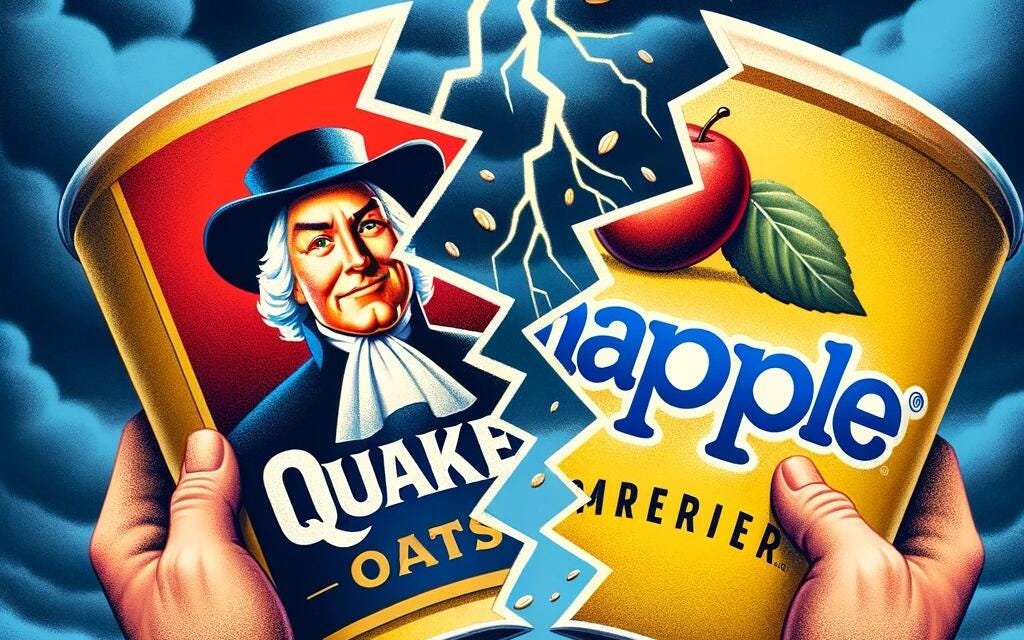Pivot Responsibly
The recent Kellanova deal seems like a perfect pivot for Mars. What can this acquisition teach you as a business leader?
Dear Readers,
I was having a conversation with a friend the other day, and he told me about a conversation he'd overheard from two investment bankers that were having lunch at the table next to his. They were going back and forth about companies pivoting the wrong way in the hopes of expanding their businesses. It got me thinking about the difficulty of nailing a perfect business pivot – whether it’s an acquisition, or simply a foray into a new category.
No one can knock it out of the park every time with a perfect pivot – anyone who has been successful in business likely has plenty of failures they can display in their “hall of shame.” That doesn’t mean we shouldn’t try to expand our businesses, but it does mean we should be very cognizant and extremely deliberate when considering a major shift in strategy.
Take the recent announcement that the candy company Mars is acquiring Kellanova, the snack food giant that was recently spun out of Kellogg. This is a $36 billion acquisition, the largest in the history of that industry. It’s not one to take lightly, so let’s examine it a bit. At the macroeconomic level, this acquisition would make sense because both are food manufacturers. But that’s actually not the correct way to view it. If Mars decided to buy a company that specialized in fresh vegetables, would you think it was a prudent business move? They are both in the business of supplying food to stores and consumers, but no one would mistake that for a smart decision. Those two businesses would have a very difficult time meshing, for a variety of reasons.
Instead, the Mars-Kellanova move makes perfect sense once you get down to the micro level. Mars is a sugary snack food company, owning such brands as Snickers, M&Ms, Milky Way, Skittles, Twix, and many more. Kellanova’s brands – Cheez-it, Eggo, Nutri-Grain, Pop-tarts, and Pringles, among others – are cemented in the breakfast-ish1 or salty snack food industries. The two companies are not selling directly competing brands, per se, but they are in the same consumer conversation when someone is deciding what snacks to purchase for themselves or their families. Their products are found in the same aisles of the food store, for the most part.
The market research and data suggest that Kellanova’s brands outperform all of their competition among Gen Z and Millennial consumers, which Mars feels will help them secure future business growth for their own products. The two companies also have strengths in different global markets: Kellanova has a strong presence in Africa, while Mars is more cemented in China. Together, the two can share distribution channels to grow the brands of both companies. Add in the cost savings of combining their research and development efforts, as well as their marketing strategies. Perhaps most importantly, the two sides believe that the cultures of each company will fit together wonderfully.
Now, all of that is just an optimistic forecast, at this stage – we have no idea how this mega-deal will end up for each company. But at face value, the line separating a good and bad pivot is much more black and white here than with most deals.
A typical opportunity is far from this clear, unless we have the benefit of hindsight. Think about an acquisition in the last 20 years that you believed was an almost perfect match, even though no one had considered it prior. A few come to mind:
Disney acquiring Marvel Brands and Lucasfilm – a company specializing in imaginary worlds that completely take over your entire being for a few hours, purchasing world-renown brands that have historically done the same.
Facebook acquiring Instagram for a then-insane sum of $1 billion – but when you really dug into the reasoning, it made sense. Facebook’s data at the time showed that the most engaged posts on their platform included a photo or a video. Instagram had the technology readily available to expand that part of the business.
Amazon acquiring Whole Foods – at the macro level, this seemed odd, because while Amazon was testing out grocery delivery programs, no one seemed to think they would be interested in hundreds of brick and mortar retail grocery locations. But Amazon wanted that physical footprint to expand their new delivery locker section. They knew that Whole Foods locations mapped nicely with a majority of their customer base, allowing them to synergize the two operations.
There are also some horrific business moves that come to mind:
Sears and Kmart merging – both companies were failing miserably and headed toward an inevitable collapse. As a brilliant hockey executive once said, “If you get one bag of shit and put it together with another bag of shit, all you get is a bigger bag of shit.”
Quaker acquiring Snapple – while both were food companies, Snapple’s product placement and marketing strategies were completely different from Quaker’s. The products were in different types of stores and were sold in different ways. Quaker didn’t see this far, and the acquisition ended up costing them millions of dollars before they eventually dumped the brand to someone else.2
eBay acquires Skype – this one seems like an obvious one. Have you ever wanted to speak with or video chat with a seller on eBay? No. I feel like the entire point of that website is desired anonymity.
The above examples are almost all acquisitions, but that isn’t necessarily the only way you can pivot. Let’s take a look at what’s going on right now in corporate America.
The current fad is artificial intelligence. Everyone and their sister is trying to explain to Wall Street how their company is related to or utilizing AI for their benefit – even if it has absolutely no relevance to their business model. It brings up memories of the dot-com bubble in the early 2000s. Similar to the explosion of the Internet, AI has some incredible potential and could change the way we live one day, but that doesn’t mean everyone should be jumping into that industry with both feet before it’s fully fleshed out. We’ve seen this before, and it’s a recipe for disaster if and when the bubble bursts.
Let’s bring this back down to the most micro level we can: your small business. The opportunity to pivot in your business can happen at any time. Perhaps you’ve been offered a new product line or entry into a new category that isn’t quite within your base offerings. Maybe you’re in the service industry, and you’ve gotten requests from customers for something you never considered, but now could add to your repertoire. The largest pivot we ever had to consider in our family business was the decision to enter a new segment of our industry. For years we had been offered opportunities to add e-commerce to our wholesale operations, but we had politely declined for a variety of reasons, the main one being that it wasn’t our core business and we were happier to support existing e-commerce companies that would then utilize our distribution network. But then an opportunity arose to acquire one of our e-commerce customers that we couldn’t decline. Not only did the culture and business strategy match up with our own, but it provided multiple direct benefits to our own wholesale efforts, which always remains the main focus. The pivot to e-commerce was not a change in business model, but a foray into a sector we knew little about. We learned quickly how to utilize this new addition to support the growth of our core business. We spent multiple years doing extensive research and strategic planning and were fortunate to execute that pivot beautifully.
There are always opportunities to expand, and there are also many roadblocks to doing so, whether it’s capital, desire, space, demand, or any of a million other reasons. The key is to really dig into the idea, from multiple angles, to ensure that it will be a responsible expansion of your business. Does the marketing strategy match the one you already use? Is the distribution model similar? How would the two operations mesh together? Can you utilize this expansion with your existing customer base, or would you need to find an entirely new clientele? Do the cultures work together, or will the businesses always have to remain separate? All of these (and more) are questions you should ask yourself before considering a pivot. A well-executed pivot can be life-changing for you and your business. But you have to ensure you’ve done the proper research. Just because another sector, product, or industry is profitable doesn’t mean it will operate properly and efficiently within your own company. And while no one is a soothsayer when it comes to business strategies, the best thing you can do as a leader is collect all the information available so you have the best chance to make the correct decision.
I say breakfast-ish, because Pop-tarts seemed like a perfectly healthy breakfast choice to me until I was old enough to know better. Same with Eggo. That doesn’t make them any less delicious, though.
Ironically, Quaker ended up being acquired by Pepsico in a brilliant move some years later. Pepsi wanted to get control of the Gatorade brand that Quaker owned, but also wanted to merge Quaker’s snack brands with their own, to great success. The two acquisitions look eerily similar on the surface, but when you dig down deeper, there was clearly a better fit with Pepsico than there was with Snapple.





Well researched and well written. If only someone could pivot to making a hindsight device, we could avoid some of these debacles. Although my Bankruptcy colleagues may be out of work at that point...